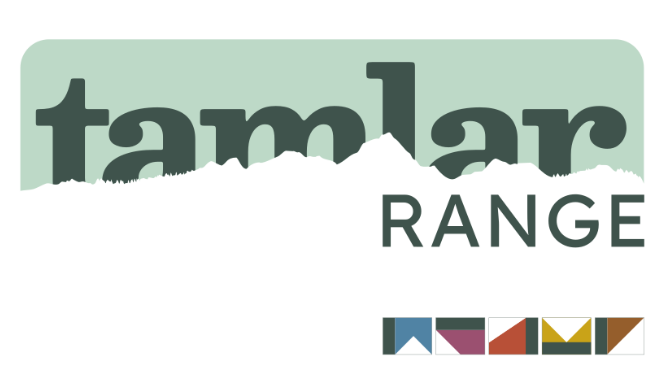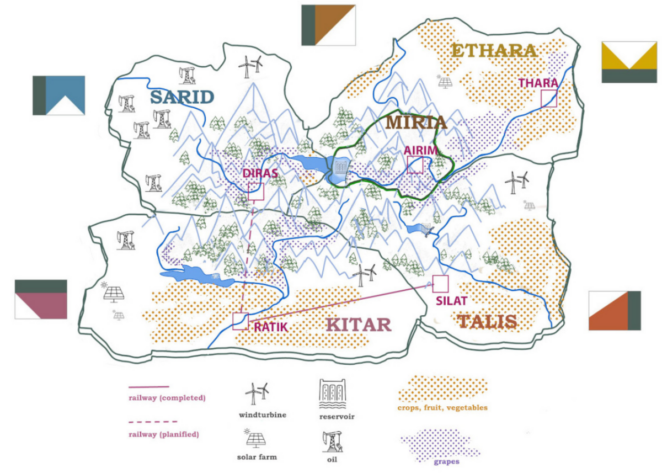The Tamlar Range Governance Simulation

Summary
Mountains are home to diverse societies and fragile ecosystems that are under serious threat. The impact of climate change is more pronounced in mountainous regions than in most other regions. Mountains provide many ecosystem services, from water supply and purification, to biodiversity, wildlife habitats, CO2 sequestration, regulation of flooding, and food production. Changes in mountain ranges are happening more quickly and with much more impact than elsewhere and are affecting life around the world. To deal with the consequences of these impacts, societies must increase their adaptive capacity, and they need to work together to do so. The simulation intends to alert participants to climate change impacts described in the last IPCC report and to simulate the interdependencies and importance of regional collaboration to face them.
The Tamlar Range governance simulation was developed in the context of Mountains Connect, a cooperation between the University of Geneva and the United Nations Environment Programme funded as part of Adaptation at Altitude (A@A). Launched and supported by the Swiss Agency for Development and Cooperation, A@A is collaborative programme that aims to boost the resilience and adaptation of mountain communities in the face of climate change.
This article is an abridged version of the original text, which can be downloaded from the right-hand column. Please access the original text for more detail, research purposes, full references, or to quote text.
Introduction
Simulations use a participatory approach to analyze a specific issue with a precise learning objective. Simulations can help participants placed in a given situation to become aware of dynamics and relationships, different stakes, and the consequences of the decisions being made.
Simulations provide an innovative setting to immerse participants in a defined and realistic space-time in which they have to make decisions and develop and implement a regional collaboration instrument.
This Tamlar Range simulation takes place in a fictional region, inspired by real-world relationships and dynamics with the mountain range extending over five countries. Each country must not only define its national priorities for improving the capacity to adapt to climate change but also face climatic and economic events that occur during the game as well as the impacts of their collective engagement in regional cooperation. The game takes place between 2022 and 2034.
The participants find themselves in this fictional universe, governed by real world dynamics. They face unexpected events, which can be both positive and negative. Thus, through negotiations, in decision-making, resource management, and consideration of short- and long-term consequences, they have to find a balance between the different issues to reach the objective of the simulation, to increase their adaptive capacity.
The simulation does not refer to any existing territory. Insights from analyses of mountain range governance experiences from around the world have been used to create the Tamlar Range.
The objective of this simulation is to collaborate and negotiate with neighboring countries that share the mountain range and to develop a regional instrument in order to confront and adapt to climate change.
In this simulation, participants are called upon to:
- Make strategic decisions for their fictional country
- Manage their resources
- Collaborate and negotiate with other countries to defend the interests of their fictional country and increase together their adaptive capacity
- Elaborate a regional instrument
Methods and Tools
Setting
The Simulation unfolds in an imaginary world where five countries – Sarid, Kitar, Talis, Ethara, and Miria – share a mountain range. The countries vary in size, population, energy profile, and resource endowment; resources include monetary reserves, knowledge (creation | application), well-being (individual | collective), agricultural production (crops | grapes | animal), water, and biodiversity.

Teams of 6–8 country representatives have the task of designing and implementing a coherent vision for achieving a desired future by means of investments in national and regional assets as well as the development of a regional governance instrument that fosters cooperation in climate change adaptation.
The simulation has no winners and losers. Climate change will continue to impact mountain regions disproportionately. A positive outcome of the Simulation is one in which adaptive capacity in the Tamlar Range increases, both at the national and the regional level.
Simulation Proceedings
The Tamlar Range Simulation includes three rounds; each round represents four years.
Participants engage in domestic and regional decision-making and experience unforeseen events. As in real life, some events are positive, others are negative; some are local, others are regional.
All decisions and events have direct consequences for a country’s resources and adaptive capacity and sometimes its energy profile. When resources fall below critical thresholds, consequences are felt across the board.
However, negative consequences can be avoided or reduced by investing in national preparedness and, especially, regional collaboration.
To this end, country teams use their monetary reserves to acquire national and regional assets. Twelve different national assets or infrastructures – e.g. an agricultural microcredit system, water treatment plant, or ecotourism extension service – help countries cope with climate change.
National assets also enable the joint acquisition of up to five different regional assets such as a renewable energy research center or an regional early warning system. Regional assets are more difficult to obtain because they are expensive and require countries to share the cost. At the same time, they offer important boosts for adaptive capacity.
Interactions
The simulation takes place in a plenary hall and country breakout rooms. Country teams deliberate in separate rooms but can visit each other by sending envoys or inviting guests.
Each country team designates two delegations to a regional forum, which is held in the plenary hall: (i) an economic delegation negotiates the purchase of regional assets and (ii) a political delegation elaborates a regional instrument that incorporates the seven governance dimensions developed in the Mountains Connect videos.
In each of the three rounds, countries purchase or sell assets (within limits), take note of the impact of events on their resources (and those of neighbors) and adjust accordingly, refine the national adaptation strategy, clarify regional ambitions, define delegations’ negotiation mandates, and prepare a national perspective on the regional instrument.
Support
Country teams and regional delegations are accompanied by coaches who encourage exchange, ensure equal access to the deliberations, and guide the participants throughout the stages of the simulation.
Each round ends with a collective debriefing on national and regional developments. The simulation concludes with an assessment of lessons learned.
Mountains Connect Interregional Workshop
The Tamlar Governance Simulation was used at the Mountains Connect Interregional Workshop. To find out more about the interregional workshop please see the links below:
Related resources
- Simulation Materials
- Tamlar Engine
- Governance Simulation Handbook
- A governance simulation to foster climate change adaptation
- La coopération régionale en mode ludique (french)
- Mountains Connect Interregional Workshop: Take-aways for interregional exchange, regional collaboration and advocacy
- Mountains Connect Interregional Workshop
- A@A Mountains Connect Interregional Workshop
- Read more about Adaptation at Altitude
(0) Comments
There is no content